![]()
EDITOR’S NOTE:
On January 31st Bindrune Recordings will release two album-length splits, one by Panopticon and Aerial Ruin, and the other by Panopticon and Nechochwen. Today, Bindrune has made both albums available for streaming, and in addition to presenting streams of both albums we’re also sharing interviews we did with all three bands after we had a chance to spend some time with the music.
In this post we talked with Austin Lunn of Panopticon and Erik Moggridge of Aerial Ruin about the music on their split, which is entirely acoustic music that presents a very introspective and personal journey for both musicians. On the Panopticon side, Austin Lunn recorded two original songs and also covered country songs by Blaze Foley and Chris Knight. On the Aerial Ruin side, Erik Moggridge unveils five new original songs.
The album, in a word, is spellbinding. It features artwork by Austin Lunn and is available for pre-order on vinyl HERE, and digitally HERE.
And now, let’s turn to the interview:
![]()
This collaboration, in hindsight, seems like something that was destined to happen some day, but what events made it a reality? Tell us what made it happen and how it came to fruition?
Austin: I saw Erik play at Shadow Woods and it was the first time I had seen him. I was really blown away by his set and I got his music off of Bandcamp and was listening to it a lot. We met again at Roadburn and swapped emails, then I saw him at Fire in the Mountains when we played there together. So within a year’s time we played 3 shows together. We were walking back to the campsite and we started talking about collaborating in some way, maybe a split, maybe him doing some vocals on some of my music, similar to what he had done with Bell Witch… so we just got to it and it worked out. Erik and I have become good friends through the process as well.
Erik: Austin and I first met when we both played Shadow Woods Metal Fest near Baltimore in 2017. Since then we also played three other festivals together and have become friends and fans of each other’s music. I think Austin mentioned the idea in passing in when we played Fire in the Mountains 2018 or maybe in an e-mail shortly after. I was of course really into the idea and kept pestering him about ’til it happened haha. We were both excited about it, just took a while to come to fruition.
How much collaboration did you two have in the songwriting? Did you keep each other abreast of what you were doing, or was it looser than that?
Austin: We both did our songs independently, though we did send demos of them to each other to check out. Erik picked the mastering engineer and we went with James Plotkin. The artwork was a lot of sketches being sent to Erik, and it took me forever…which I endlessly apologize to him for, hahah.
Erik: We sent each other clips and later the pre-mastered, almost-complete mixes, but there were no guidelines really, except Austin wanted his side to be wholly acoustic and perhaps felt it appropriate to do something really personal.
For Austin, I have to begin by asking about the two cover songs. I’ve talked with you enough about country artists that we both hold close to us, and I know Blaze Foley is way up there in your mind, as he is mine (especially given his connections to Austin, Texas), but how did you choose this particular song by him? What made “Cold Wold World” stand out as something you wanted to play for yourself on a this recording?
I chose “Cold Cold World” because it was one of his songs that isn’t a love song and I felt that lyrically it fit me better. I have been a huge Blaze Foley fan for many years and his work means a lot to me. I sang the song a little differently than I normally sing, trying to be cleaner since there’s a lot of vocal harmony, so that was a challenge. I relate to that song a lot, as I have long dealt with depression, and this song reminds me of times in my life when I just wanted to give up. There’s a lot of levity in the song… making light of the despair that we as humans often feel in our day-to-day lives… the grey wash of monotony… waking up and doing the same things over and over and just trying to ride it through until good times return again.
Blaze sings:
I’ve tried for a long time but I think I can’t win
I’d do it all better if I could do it a-gain
Wherever I’m going it’s the same place I been
Ain’t it a cold, cold world
Outside it was hot but inside I am cold…
I think I know you well enough that there’s more hope in you than this. Do the dark times still put their hands on you?
Theres a degree of fatalism in the lyrics to this song that I can identify with….we all live with our failures and regrets… It’s important not to repeat those things, but we also know that we are bound to make new mistakes that we will need to learn from. Some times that wall that we just have to keep on climbing feels like an unconquerable foe, but we just gotta keep climbing, owning our mistakes and striving to get better.
The cover is faithful, but I can hear the things you did with it, the accents you added. They make it even more haunting. How do you decide to do a cover of something that’s clearly dear to you and still feel free to put your own touches on it?
I’ve learned many many Blaze songs over the years (haha, as evident by the cover set I did at Austin Terror Fest) and have played many of his songs at my acoustic sets over the years… I always kind of change any song I learn to fit my style since I am not a particularly good singer… so I have to work within my abilities. So to kind of cover up some of my vocal failures, I like to add a little extra instrumentation to distract from my voice, to be honest.
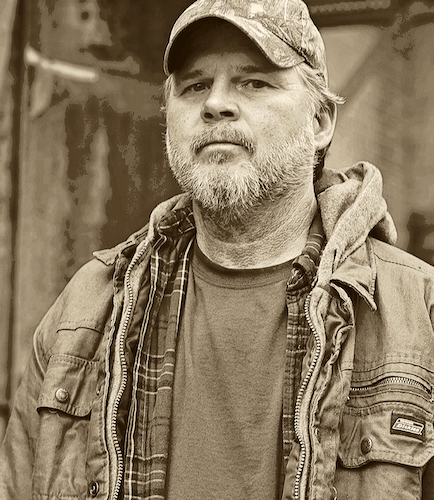
Chris Knight
The other cover is by Chris Knight. Younger guy, a Kentucky man (even though he was named an honorary Texan by the sleazebag governor Rick Perry), worked as a mining guy, and unlike Blaze is still alive. I think you were the person who pointed me to his music, though I feel like I still haven’t scratched deep enough. What was your own attraction to “North Dakota”? I love the original — it’s absolute magic — but you know so many honest and haunting country songs, why this one, which is almost 20 years old now?
That song is something I can really relate to as North Dakota neighbors the state I live in currently, Minnesota, and the harsh winters are something I am well acquainted with… so the lyrics really appealed to me a lot. The lyrics are stark and simple but employ some really brilliant literary devices and juxtaposition of words… for instance, how he says “My heart was pounding in my throat, I searched and called her name until it was raw”. He didn’t say what was raw but the listener can deduce that he meant his throat by the previous line.
I love that he uses such simple language to build a story that is cinematic, he uses so few words to describe the story with such depth… there is no wasted language in the song… every single word is meaningful… I think his writing is brilliant. My favorite version of this song is just him, his guitar. and a mandolin. It’s available on iTunes and there is also a video of that performance on YouTube… I think the stripped-down version is so haunting and perfect. Also another favorite is the song “Rural Route” if anyone gets curious… theres a great live version on YouTube… I think that songs is a short film down with only a guitar and voice…
The Chris Knight original includes an apparitional fiddle chorus and lonesome banjo picking, both of which get me every time I hear it. You added your own instrumental accents — I hear a steel guitar in place of the fiddle, as well as a banjo — and the song seems to me even darker, maybe in part because of the difference in timbre between your voice and Knight’s. The song seems even more like a spell, and with even more loss and heart-ache than the original. I’ll ask again, how do you put your own marks on a song that clearly means a lot to you?
I struggled with recording this song as I think part of the magic of it is Chris’s amazing voice and heavy accent… his music is so full of authenticity… even though I was born and raised further south than he was, I don’t have a particularly strong accent, so to add some of that feeling I added the square neck resonator for atmosphere, kept the mandolin that is heard in my favorite version of the song, drank a few beers and smoked a couple cigarettes to let my voice be a little extra scratchy and gravelly and just sang from the heart as best I could… trying to play the lyrics like a movie in my mind, visualizing the events… much the same as I did on the song “Beast Rider” from Scars… that song certainly took some cues from Chris Knight.
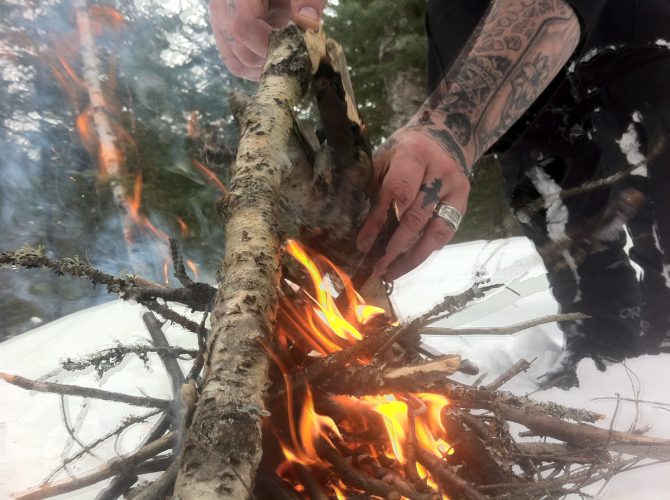
Well, forgive me with starting on the cover songs. Curiosity got the better of me. Speaking of spells, the first original Panopticon track, “No Lines Away” — I think that might be the best country song you’ve recorded yet. It’s so terrifically sad, and sounds so personal. It’s entrancing, but I think will make most people think of someone they’ve lost. It did me. I have to ration how much I listen to it, because it makes me want to cry. And the plaintive bowed music just jabs the spear into the heart even deeper. I also hear a lower bowing tone, so maybe this is a cello, or a bass, or two or three instruments? Where did this song come from, and who played the bowed instrument(s)?
The cello on “No Lines Away” and “The Pit” was performed by my friend Patrick, from Dämmerfarben, and I think he really makes the song….brings so much sadness to it.
Lyrically the song is pretty old… I wrote it nearly 3 years ago. It’s about something I struggle with a lot… this longing feeling of wishing I was someone else… wishing my life had been different… Over the years I have been so many amazing places, met so many special people… places and people I will always live far away from. Most of my friends live very far away. So the song is about how as we travel through our lives, that bittersweetness pulls us away, but the final lines of the song are about being drawn home… ”to love and light, forest and hearth”… that no matter how far we go, the beautiful places and people we meet along the road, what draws us home are those we love and the places that are home.
I often find that, even when I return to Kentucky to see my family and friends, I have begun to yearn for the pine, spruce and birch trees of Minnesota, the calm of the snow in winter…. and often on those long drives, I sigh a breath of relief when I see the tall pines in Wisconsin. So even though there are many places and many people I value dearly, home will always draw me back to where I belong… with my family, my wife and children. That doesn’t take away from the importance of these experiences… because we leave pieces of our selves everywhere we travel… but we also take pieces of those places with us when we leave… and I think there’s deep poetry in that exchange.
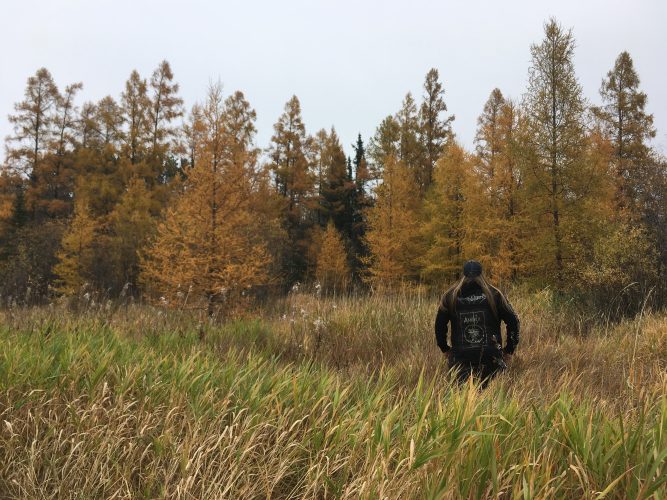
That original song leads really well into the covers, and then you’ve got “The Pit” at the end, which complements everything that precedes it. The banjo dances and wails, and there’s a vibrancy in your guitar picking, and the music eventually seems to elevate from the ground, arms wide and slowly spinning, like there’s nothing left in the world worth hanging onto. But there’s darkness in the music too, in your voice and in the words, and beautiful grief in the fiddle music. Did I say “No Lines Away’ was the best country song you’ve recorded? Let me re-think that… And in the meantime, what inspired this enthralling tune?
Haha, thanks. I am glad you liked that song.
“The Pit” is very personal and deals with coming to grips with my personal failures and mistakes, being so drowned in my own failures that I didn’t even know which way was up anymore. What it comes down to is putting the shovel down and just climbing out of the hole. Stopping trying to turn a bad situation into good, and simply getting out of it. So many of my own problems are of my making, and I just hardheadedly dug the pit deeper and deeper. I needed to learn to just stop and admit failure and atone for it. And this song is about that… simply climbing out of the hole I dug.
Ironically, I have played another Chris Knight song with this song called “Out of This Hole”. There’s an old tradition of “answer songs”, where a song writer will write a song in response to another song… for example, Kris Kristofferson’s song “The Race” is an answer song to “The Wind Beneath My Wings”. “The Race“ ends with “you are the shit beneath my shoe”; in this situation I was the shit beneath my own shoe… forcing myself to face my own shortcomings and mistakes. “The Pit” works in reverse to “Out of This Hole”, since Chris Knight’s song already told me what I needed to do…. I needed to admit my wrongs and failures, and dig out of the hole. So I wrote a song that was more of the question rather than the answer. I needed to get out of the pit and strive towards being a better man.
Before I leave you, what did you think of Erik’s s five Aerial Ruin songs on this split?
Erik’s songs are beautiful, ethereal and deeply personal. His musicianship is amazing, but his voice is like no other. He has this incredible gift of voice. So I always love his music, but these songs have a special magic to them. In particular “The Sanguine of Ale” and “ Epilogue Centauri”. I love the entire record, but the first and last track have this magic to them… And his live performances truly are a spectacle… it’s incredible to hear what just one man, a guitar, and some looper pedals are capable of creating, live before our very eyes and ears.
https://thetruepanopticon.bandcamp.com
https://panopticonmerch.bigcartel.com
https://www.facebook.com/TheTruePanopticon/
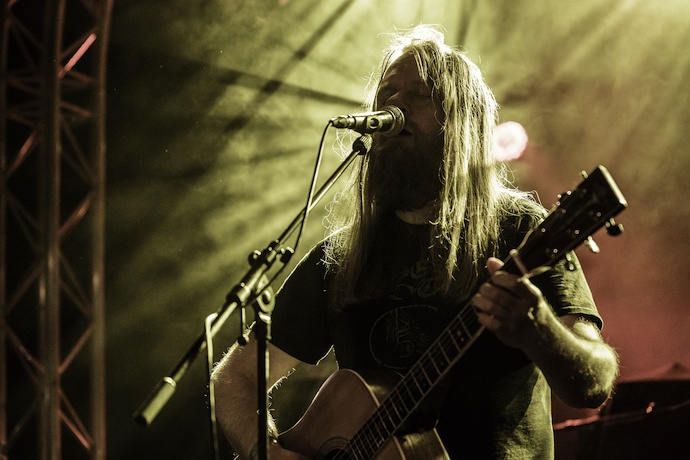
photo by Diana Lungu Photography
A few questions for Erik about the five Aerial Ruin tracks. You’ve already carved a place for yourself in folk music with songs that, at least as I hear them, have one foot in our world and the other in a very different one that we can’t touch with our hands or see clearly with our eyes. And these new songs likewise seem to put their fingers on very human hearts, but the fingers themselves belong to spirits. The music is so spellbinding, so beautiful, so poignant, but yet so chilling to me. In composing these songs, did you have any kind of special objective, different from (for example) what you did on Nameless Sun?
Thanks for the kind words, I really appreciate your description of Aerial Ruin and how you expressed your impression of of these songs.
Primarily my objective was the same as with all other Aerial Ruin recordings since all my songs are “about” the same thing. They are all a psychedelic, spiritual meditation on the loss of the self and the collapsing of metaphor and symbolism to something perhaps more real than anything we experience in this life. Or perhaps the edge of that plane, the fine line between the intensely personal and the death of the ego.
From this perspective (or lack thereof) I find many spiritual expressions to have a new power. Chief among these is the fall of Lucifer and the rebel angels. I find something very real here that need not be literally true.
However, this description of Aerial Ruin and others similar in past interviews is my way of thinking about it after the fact. It usually flows out without much or any forethought. And within this larger “theme” sometimes something more specific or a little closer to an actual narrative emerges. This was the case with many of the songs on Nameless Sun. Here I was thinking about the parallels of the distance one feels from loved ones who have died and the immense distance to the nearest star from our sun Proxima Centauri. These are two different forms of distance that seem insurmountable, though interstellar travel is much aspired to and the journey from this life is one we all will take. Another inspiration was the fragility of life versus the intense uncaring violence of stellar nuclear fusion on which it depends.
My side of this split with Panopticon is in some ways side three of Nameless Sun, though not by intention.. The closing song “Epilogue Centauri” picks up directly after Nameless Sun. This differs from how I imagine my next album being, as a different character tends to develop more naturally on a full-length than a side of a split or an EP.
Anyway, hopefully this answer doesn’t sound too fucking long-winded and pretentious haha
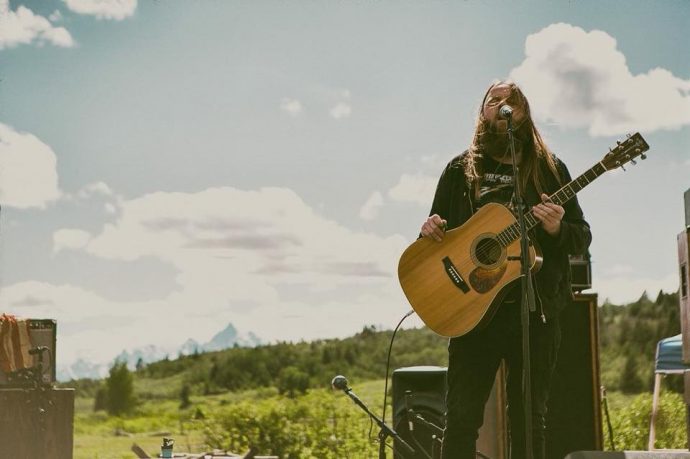
photo by Bobby Cochran Photography
The ghostly guitar melody and somber tones of your vocals in “Sanguine of Ail” really seem like a soundtrack to a conveyance across the Styx. But there’s greater tension, anxiety, but also wonderment in “Lesser the Blade”. And on the other hand, “The sea is now steam in mist of a scream” is heart-breaking but so beautiful (and it pitches me back to a certain kind of folk music from the ’60s), while the picking in “Asempyrean” seems to ripple like slow, sun-dappled and tree-shaded streams (I got flashes of Simon & Garfunkel in that song too).
But those are my impressions. If you have the patience, could you comment on what inspired you about each of the five songs, and what you sought to accomplish with them? And if you have even more patience, what kinds of music or artists influenced these compositions?
Certainly. As I touched on “Epilogue Centauri” in the last question I will describe the other four here.
In “Sanguine of Ail” I imagine a slow drift of a walk to the ocean after thawing from being frozen in an icy cliff. The beckoning of the water and the slow sinking into its depths after floating on the surface peacefully. The frozen state perhaps represents life and joining of the sea the blissful relief and freedom of its end. The last four lines are thoughts I imagine I may myself be thinking when it’s my time to sink.
“Lesser The Blade” I was thinking about war and all the things that need fail for it to burn and thrive. Each verse has a key phrase that expresses this “the failure to kill is denied”.
“The sea is now steam in mist of a scream”, like “Epilogue Centauri” is much in line with the Nameless Sun songs and is a journey upwards and away from the earth’s surface as the ocean boils and turns to steam.
“Asempyrean” relates the sensation of weightlessness to the shedding of the body and liberation of consciousness to somewhere unknown.
As far as what I sought to accomplish with them I am just continuing this journey. Whether it could be said to have a purpose I do not know.
And as far as influences go I would not say there are any specific to these songs but in general I think Mark Lanegan and Syd Barrett’s solo albums certainly influenced Aerial Ruin.
So much of what I listen to is inspiring in the sense that it makes me want to create but does not overtly influence Aerial Ruin musically or thematically, as that inspiration comes from elsewhere it seems. Of course everything is an influence in a sense. but perhaps those of my heavier bands Epidemic and Old Grandad were more obvious as I have spent more of my life in the metal world than anywhere else.
Did you have any guests or special help with the songs that you’d like to credit, or was this all you?
These were written and performed by me alone, although I have enjoyed occasionally having talented friends guest on older albums. I would like to mention that my friend Dave from Lot 3 Audio did a great job recording these. as he has much of my other work, likewise for James Plotkin on the mastering. And of course Austin for making the whole thing happen.
I see that Austin created the cover art for this split. Can you tell us what conversations the two of you had to bring that about?
Austin told me what his songs were about and asked what mine were about. I think I simply said “the loss of the self” and from this he worked his magic and came up with this beautiful cover. He sent me progress shots as he worked on it and I liked it every step of the way and wanted to let him do his thing without interfering. It’s very much his piece of art and helps make our record a special release I think.
Since I’ve asked Austin what he thought of your songs, what do you think of his?
I absolutely love them. “The Pit” is possibly my favorite of the acoustic Panopticon songs and has so much emotion, great lyrics. and the cello accompaniment is wonderful. The cover songs prove again how good Austin is at bringing his own feel to songs he is a fan of. I love the lines in “North Dakota” — “I ain’t the kind that believes in ghosts, but some nights I get pretty close” — and it’s been cool to discover Chris Knight and Blaze Foley as a result, as I am not that familiar with country. The whole side is great and the way the originals bookend the covers gives it the perfect flow.
Obviously these four songs only represent a slice of the expansive sound of Panopticon, so I think it’s great that our split is coming out at the same time as his split with Nechochwen. His song on that other split is dynamic, epic in scope, and layered of brilliance like his other heavier material. That combined with the fact that Nechochwen is a great band make these two splits great twin releases in my opinion. And the fact that Austin has created all these amazing Panopticon records almost entirely by himself, and that each one has its own feel and so much depth, is really quite astounding. It’s an honor to share this record with him.

I’m loving these Panopticon tracks. So good.
“I saw Erik play at Shadow Woods and it was the first time I had seen him. I was really blown away by his set and I got his music off of Bandcamp and was listening to it a lot.”
I talked to Austin through that whole damn set! It’s a testament to just how great Erik is though if Austin managed to be blown away while still being distracted by me. I apologize to both gentlemen, and I tried to make up for it by buying Erik’s complete discography and tried to help him pick up a fill-in gig in the NE PA area, but when you get to talking to Austin it’s an incredible experience. I’ve been to every Shadow Woods, and they have always been fantastic, but that one was truly magical. This year’s, with Panopticon returning along with Falls of Rauros, is looking like another winner. If you can make this event, do it!